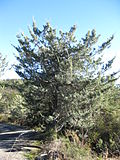| Cupressus | |
|---|---|
 | |
| Cupressus sempervirens | |
| Scientific classification | |
| Kingdom: | Plantae |
| Clade: | Tracheophytes |
| Clade: | Gymnospermae |
| Division: | Pinophyta |
| Class: | Pinopsida |
| Order: | Cupressales |
| Family: | Cupressaceae |
| Subfamily: | Cupressoideae |
| Genus: | Cupressus L. |
| Type species | |
| Cupressus sempervirens | |
| Species | |
See text | |
| Synonyms [1] | |
| |
Cupressus (common name cypress) is one of several genera of evergreen conifers within the family Cupressaceae; for the others, see cypress. It is considered a polyphyletic group. Based on genetic and morphological analysis, the genus Cupressus is found in the subfamily Cupressoideae. [2] [3] The common name "cypress" comes via the Old French cipres from the Latin cyparissus, which is the latinisation of the Greek κυπάρισσος (kypárissos). [4] The name derives from Cyparissus, a mythological figure who was turned into a tree after killing a stag.
Contents
- Description
- Cultivation
- Cultural references
- Taxonomy
- Phylogeny
- Species
- Allergenic potential
- References
As currently treated, these cypresses are native plants in scattered localities in mainly warm temperate climate regions in the Northern Hemisphere, including northwest Africa, the Middle East, the Himalayas, southern China and northern Vietnam. [1] As with other conifers, extensive cultivation has led to a wide variety of forms, sizes and colours, that are grown in parks and gardens worldwide. [5]














































